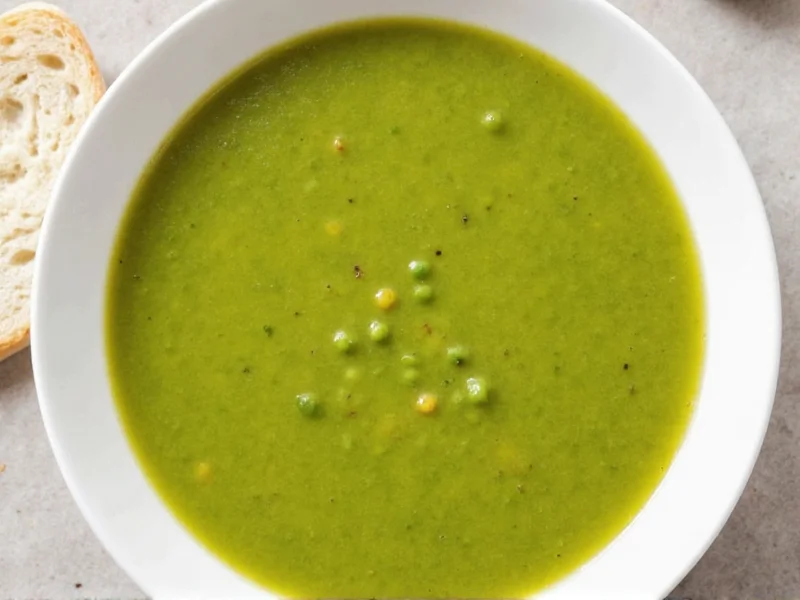This easy pea soup recipe delivers creamy, flavorful soup in just 30 minutes using 7 simple ingredients. Perfect for beginners, this classic recipe requires no special equipment and works with fresh or frozen peas. The secret to rich flavor without heavy cream? A combination of sautéed aromatics and proper seasoning technique.
The Perfect Weeknight Pea Soup Solution
When you need a comforting meal fast, this easy pea soup recipe saves the day. Unlike complicated versions requiring hours of simmering, our streamlined approach maintains authentic flavor while cutting preparation time significantly. The key is understanding how to maximize flavor from basic pantry staples without compromising texture or taste.
Why This Easy Pea Soup Recipe Works
Many "quick" pea soup recipes sacrifice depth for speed, resulting in bland, watery soup. Our method preserves the sweet, earthy notes of peas through strategic ingredient layering. By properly sautéing onions, garlic, and celery before adding liquid, you build a flavor foundation that transforms simple ingredients into something extraordinary.
| Prep Time | Cook Time | Total Time | Servings |
|---|---|---|---|
| 10 minutes | 20 minutes | 30 minutes | 4 servings |
Simple Ingredients for Maximum Flavor
This easy homemade pea soup recipe uses accessible ingredients you likely already have:
- 1 tablespoon olive oil or butter
- 1 medium onion, finely diced
- 2 cloves garlic, minced
- 1 stalk celery, finely chopped
- 4 cups fresh or frozen peas (no need to thaw)
- 4 cups vegetable or chicken broth
- Salt and freshly ground black pepper to taste
- Optional: 2 sprigs fresh mint or 1 teaspoon dried
Step-by-Step Instructions for Foolproof Pea Soup
- Sauté aromatics: Heat olive oil in a large pot over medium heat. Add onion and celery, cooking until softened (5-7 minutes). Add garlic and cook 1 minute more until fragrant.
- Add peas and broth: Stir in peas, broth, and mint (if using). Bring to a gentle boil, then reduce heat to maintain a simmer.
- Simmer for flavor development: Cook uncovered for 15 minutes, allowing flavors to meld. Avoid overcooking, which can cause peas to lose their vibrant color.
- Blend to creamy perfection: Using an immersion blender, puree about half the soup directly in the pot. For traditional blenders, cool slightly and blend in batches. This partial blending creates ideal texture—creamy with some whole peas remaining.
- Season and serve: Return to low heat, season with salt and pepper. Taste and adjust seasoning. The best easy pea soup recipe balances natural sweetness with subtle savory notes.
Pro Tips for the Best Results
Even the simplest easy pea soup recipe benefits from professional techniques:
- Temperature control: Never boil vigorously after adding peas—gentle simmering preserves color and texture
- Seasoning strategy: Add salt in stages—half during cooking, half at the end for optimal flavor perception
- Texture secret: Reserve 1/4 cup whole peas before blending to stir in at the end for visual appeal
- Flavor boost: A squeeze of lemon juice just before serving brightens the entire dish
Variations for Different Dietary Needs
This versatile easy frozen pea soup recipe adapts beautifully to various preferences:
- Creamy version: Stir in 1/4 cup coconut milk or heavy cream after blending for extra richness
- Protein boost: Add diced ham during the sauté step for a traditional easy pea soup recipe with ham
- Vegan option: Use olive oil instead of butter and ensure broth is vegetable-based
- Herb variations: Try tarragon instead of mint for a more sophisticated flavor profile
Storage and Reheating Guidelines
Pea soup maintains excellent quality when stored properly:
- Cool completely before storing in airtight containers
- Refrigerate for up to 4 days
- Freeze for up to 3 months (soups with dairy should be consumed within 1 month)
- Reheat gently over medium-low heat, adding small amounts of broth if needed
Common Mistakes to Avoid
Even the easiest pea soup recipe can go wrong without proper technique:
- Over-blending: Creates an unappealing, gluey texture—partial blending yields best results
- Under-seasoning: Peas require proper salt to shine—taste and adjust before serving
- Using old frozen peas: Stale frozen peas lose sweetness—check expiration dates
- Rushing the sauté: Properly cooked aromatics form the flavor foundation—don't skip this step
Frequently Asked Questions
Can I make this easy pea soup recipe without a blender?
Yes, you can skip blending entirely for a chunkier texture. Simply mash some peas against the pot side with a spoon during the last 5 minutes of cooking. The soup will still be creamy from the broken-down peas while maintaining visible texture.
How do I prevent my pea soup from turning brown?
To maintain vibrant green color, avoid overcooking and never boil vigorously after adding peas. Adding an acid like lemon juice at the end also helps preserve color. If using frozen peas, don't thaw them first as this can cause discoloration.
What's the best substitute for fresh peas in this recipe?
Frozen peas work perfectly in this easy frozen pea soup recipe and often taste fresher than 'fresh' peas out of season. Avoid canned peas as they become too mushy. If using frozen, add them directly to the pot without thawing for best texture and color retention.
Can I make this pea soup vegetarian or vegan?
Absolutely. Use vegetable broth instead of chicken broth and olive oil instead of butter for a vegan version. The natural sweetness of peas shines through beautifully in this vegetarian pea soup recipe easy to prepare. For extra richness without dairy, blend in 1/4 cup cooked white beans.
How can I add more protein to this easy pea soup recipe?
Stir in 1/2 cup cooked quinoa or lentils during the last 5 minutes of cooking. For non-vegetarian options, diced ham added during the sauté step creates a traditional easy pea soup recipe with ham. Poached eggs served on top also add protein and richness.











 浙公网安备
33010002000092号
浙公网安备
33010002000092号 浙B2-20120091-4
浙B2-20120091-4